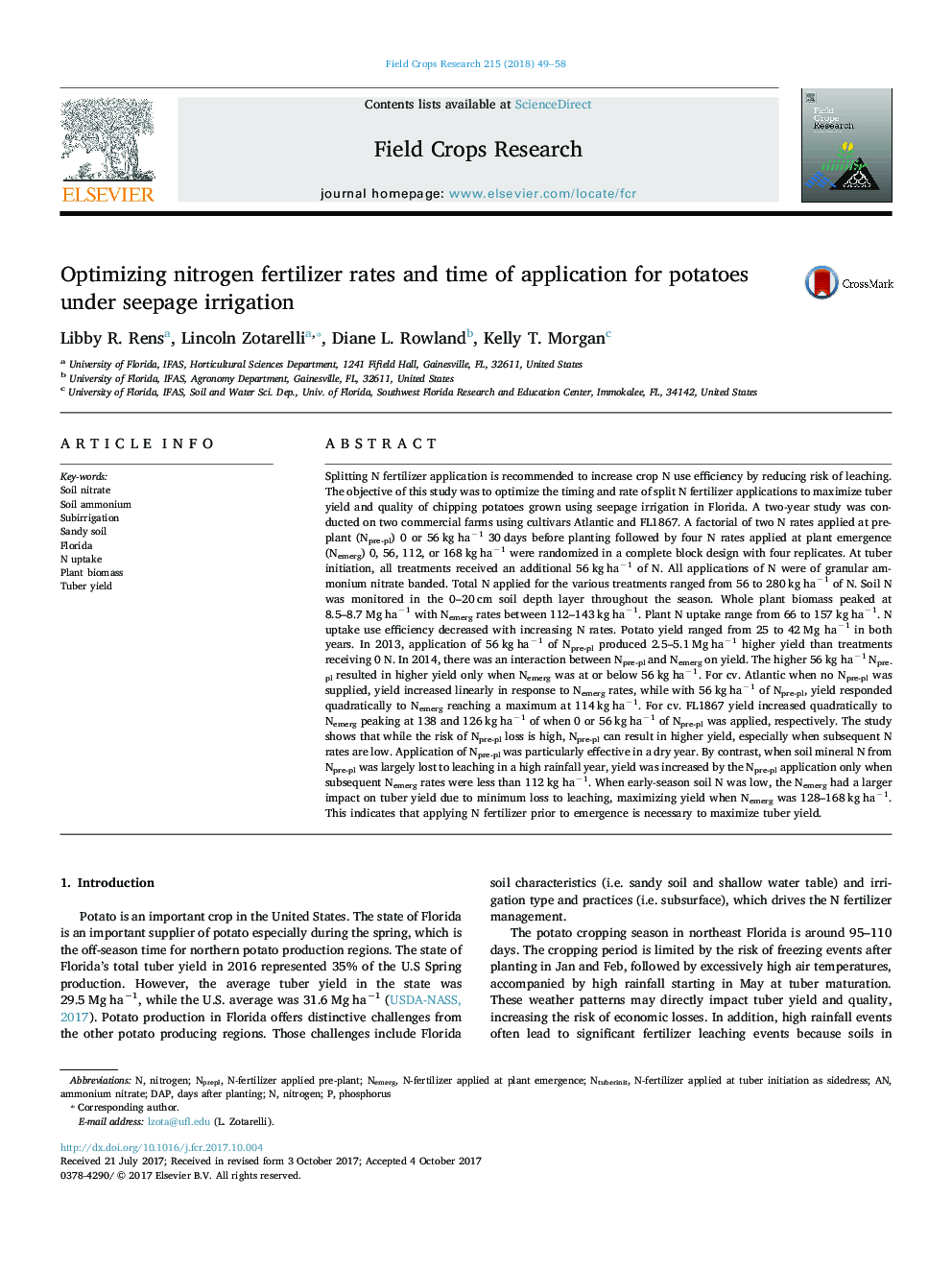| Article ID | Journal | Published Year | Pages | File Type |
|---|---|---|---|---|
| 5761455 | Field Crops Research | 2018 | 10 Pages |
Abstract
Splitting N fertilizer application is recommended to increase crop N use efficiency by reducing risk of leaching. The objective of this study was to optimize the timing and rate of split N fertilizer applications to maximize tuber yield and quality of chipping potatoes grown using seepage irrigation in Florida. A two-year study was conducted on two commercial farms using cultivars Atlantic and FL1867. A factorial of two N rates applied at pre-plant (Npre-pl) 0 or 56 kg haâ1 30 days before planting followed by four N rates applied at plant emergence (Nemerg) 0, 56, 112, or 168 kg haâ1 were randomized in a complete block design with four replicates. At tuber initiation, all treatments received an additional 56 kg haâ1 of N. All applications of N were of granular ammonium nitrate banded. Total N applied for the various treatments ranged from 56 to 280 kg haâ1 of N. Soil N was monitored in the 0-20 cm soil depth layer throughout the season. Whole plant biomass peaked at 8.5-8.7 Mg haâ1 with Nemerg rates between 112-143 kg haâ1. Plant N uptake range from 66 to 157 kg haâ1. N uptake use efficiency decreased with increasing N rates. Potato yield ranged from 25 to 42 Mg haâ1 in both years. In 2013, application of 56 kg haâ1 of Npre-pl produced 2.5-5.1 Mg haâ1 higher yield than treatments receiving 0 N. In 2014, there was an interaction between Npre-pl and Nemerg on yield. The higher 56 kg haâ1âNpre-pl resulted in higher yield only when Nemerg was at or below 56 kg haâ1. For cv. Atlantic when no Npre-pl was supplied, yield increased linearly in response to Nemerg rates, while with 56 kg haâ1 of Npre-pl, yield responded quadratically to Nemerg reaching a maximum at 114 kg haâ1. For cv. FL1867 yield increased quadratically to Nemerg peaking at 138 and 126 kg haâ1 of when 0 or 56 kg haâ1 of Npre-pl was applied, respectively. The study shows that while the risk of Npre-pl loss is high, Npre-pl can result in higher yield, especially when subsequent N rates are low. Application of Npre-pl was particularly effective in a dry year. By contrast, when soil mineral N from Npre-pl was largely lost to leaching in a high rainfall year, yield was increased by the Npre-pl application only when subsequent Nemerg rates were less than 112 kg haâ1. When early-season soil N was low, the Nemerg had a larger impact on tuber yield due to minimum loss to leaching, maximizing yield when Nemerg was 128-168 kg haâ1. This indicates that applying N fertilizer prior to emergence is necessary to maximize tuber yield.
Keywords
Related Topics
Life Sciences
Agricultural and Biological Sciences
Agronomy and Crop Science
Authors
Libby R. Rens, Lincoln Zotarelli, Diane L. Rowland, Kelly T. Morgan,
